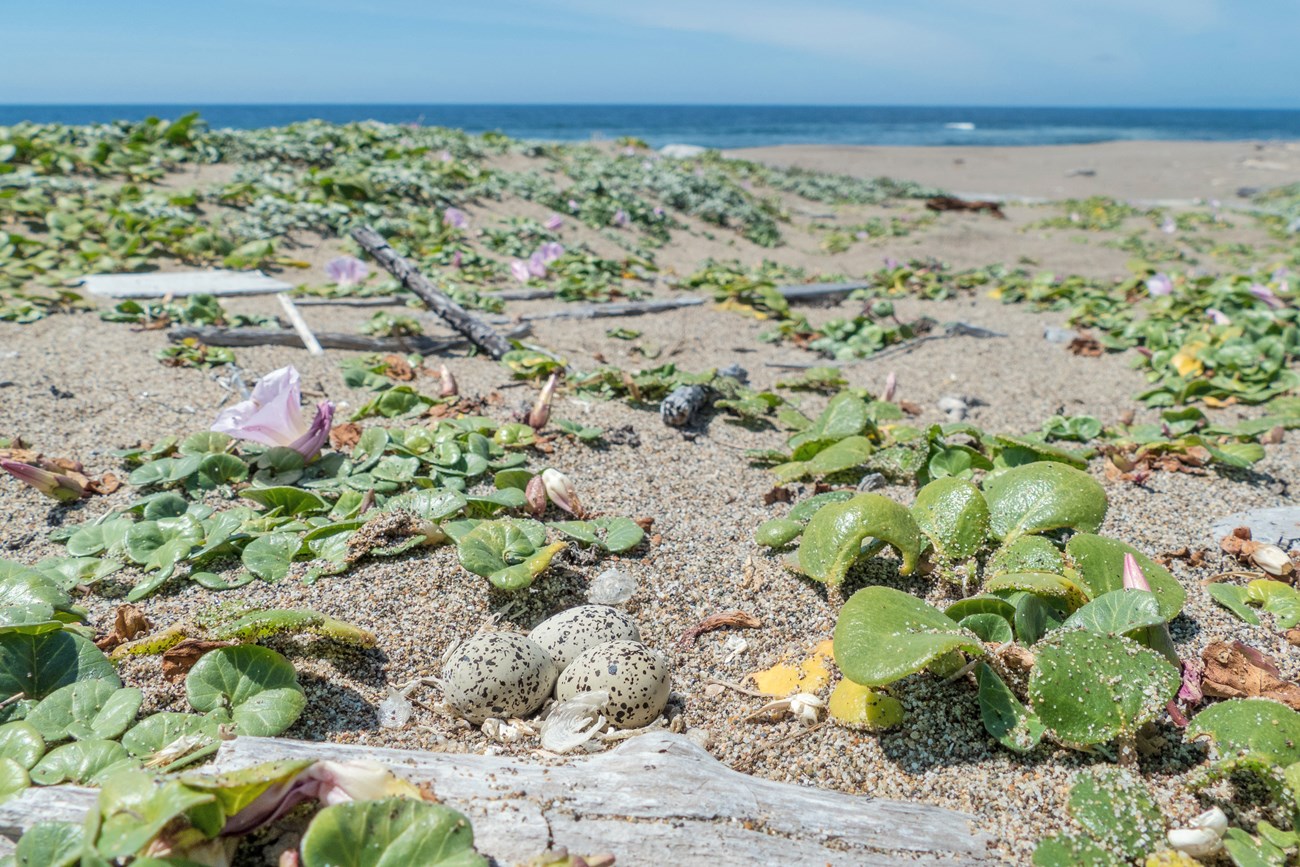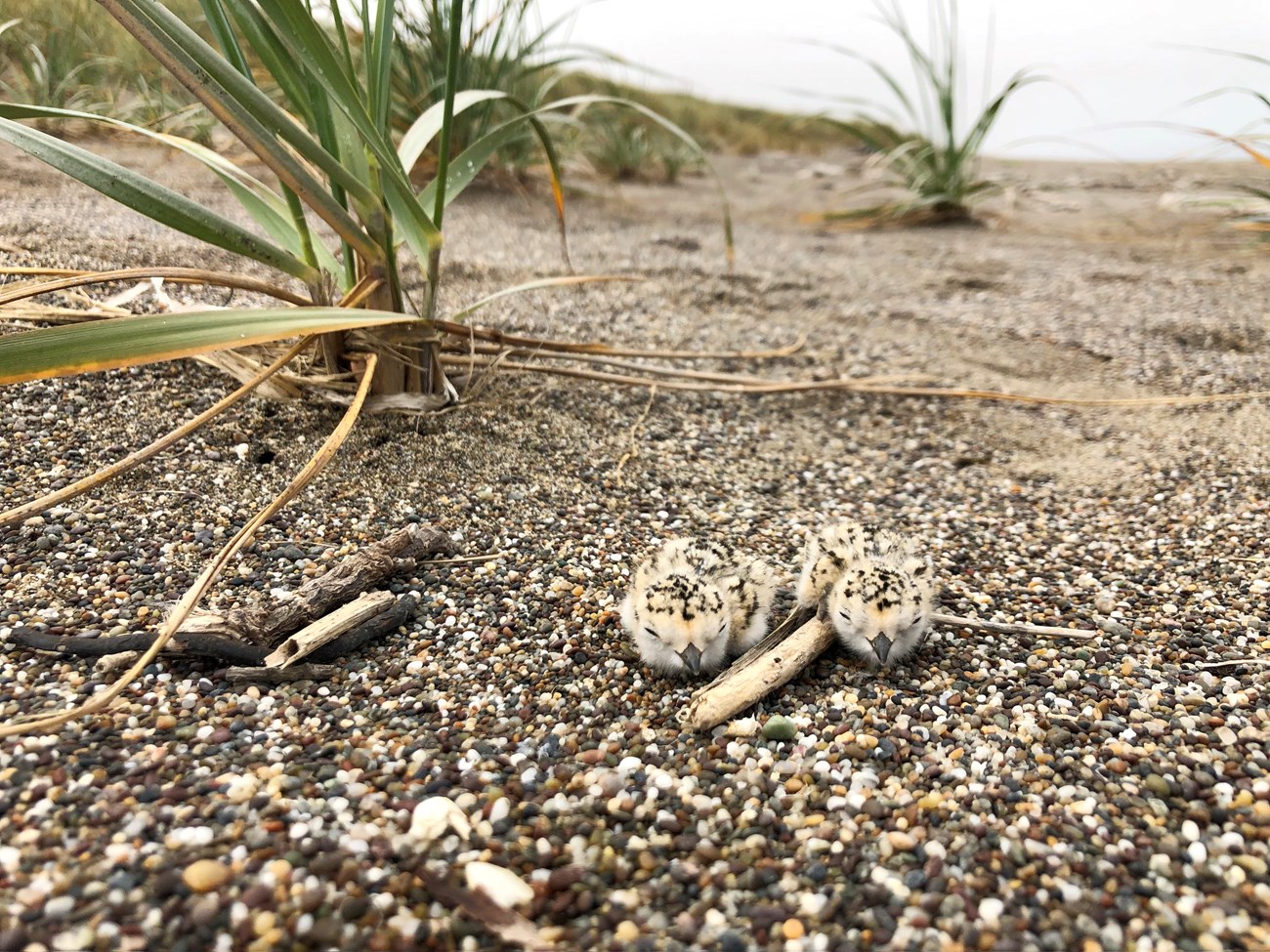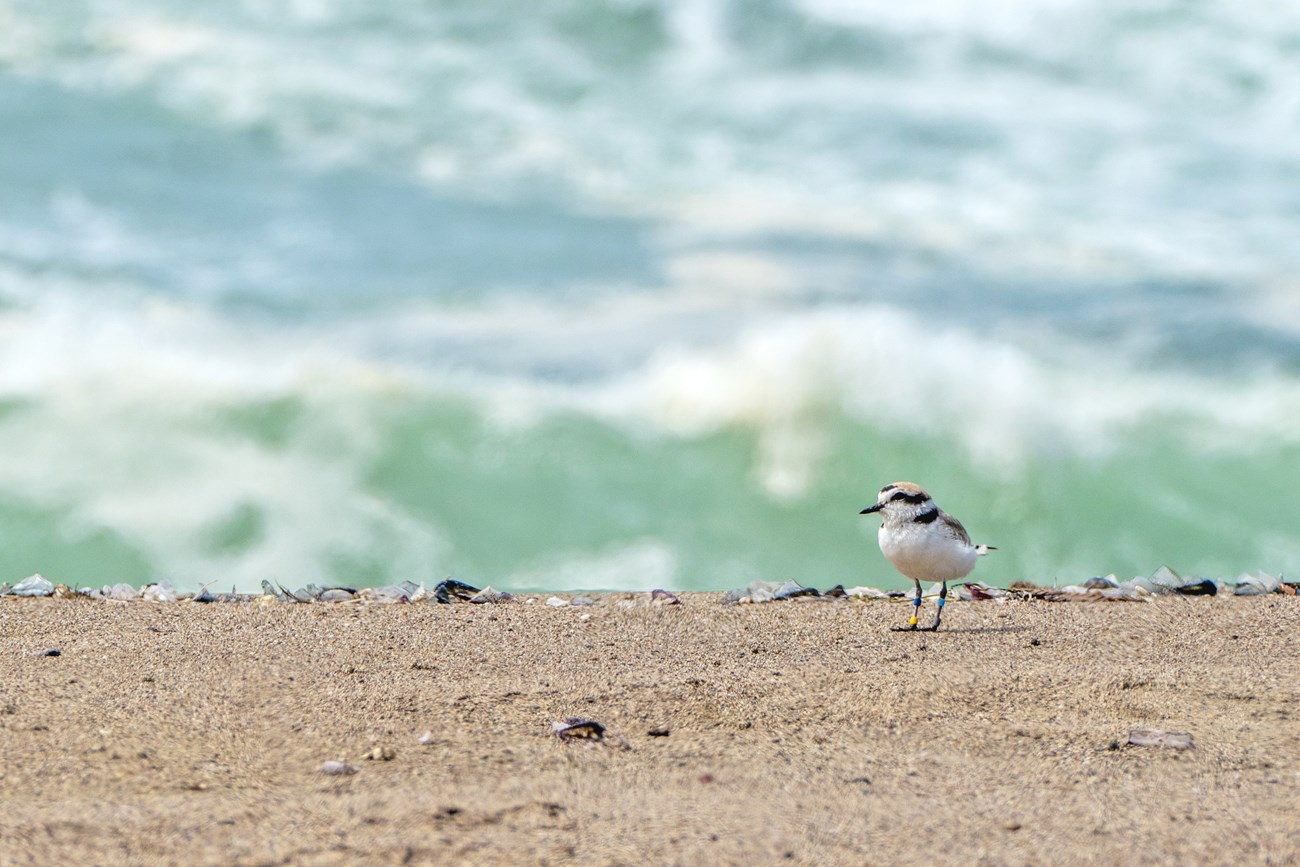Last updated: February 7, 2025
Article
Understanding the Space Between Land and Sea Through the Eyes of Snowy Plovers

NPS / Matt Lau
December 2022 - Limantour Beach is wide. Bookended by ocean on one side and grassy dunes on the other, its sandy expanse provides a habitat for many organisms that rely on the rich ecosystem between land and sea.
The western snowy plover (Charadrius nivosus nivosus), a small brown and white shorebird, is one species that finds refuge in the sand. Snowy plovers are nervous creatures that rely on the beach’s width and undisturbed nature. Plovers are low on the food chain and need a 360° view of the world around them to watch for predators, like hawks and ravens, that might snatch an egg or a whole bird at a moment’s notice.
During their March-September breeding season, Point Reyes plovers lay their eggs directly in depressions that they create on the sand of beaches like Limantour or North Beach. Their brown backs camouflage them from above, and they use bits of driftwood, eelgrass, and other beach debris to help their nests blend in. Still, plover parents are exposed, but it’s worth it for them to have the best view possible.
Dunes covered in native grasses are their friend too. When not nesting on the beach, plovers can lay their eggs in and around American beachgrass, which has historically lined the dunes. American beachgrass is sparse and low enough that plovers can find refuge in its strands while maintaining their vigilance against predators.

NPS / Matt Lau
The health and fate of Point Reyes’ snowy plovers are, in fact, so closely tied to the health of the dunes and beach that they are what is known as an indicator species. Their health “indicates” the health of the ecosystem. If the beach is disturbed – whether by human influence or a shift in natural conditions – the plovers’ population numbers will likely reflect the change. Snowy plovers are already classified as federally threatened, meaning that current conditions could result in endangerment status down the line, making the potential impact of beach disturbances even greater. .
Point Reyes wildlife biologists have been monitoring the plovers since the 1980s to learn how to protect these small birds and track changes in the surrounding beach habitat. Understanding the birds’ population shifts can help scientists pinpoint issues in the ecosystem. Resolving those issues then helps the plovers stay alive and healthy, which also helps other native plants and animals that live alongside them.
The ecosystem at the beach hangs in balance, supporting many different creatures and maintaining a natural ebb and flow of wildlife that echoes that of the tides. Over time, human activity and development have degraded the pristine, wide beach between land and sea, and biologists have seen those impacts through the eyes of the snowy plovers.
On the inland side, plovers have already lost acres of otherwise useful nesting area. The American beachgrass and other native dune plants that plovers prefer for nest building are being outcompeted by invasive European beachgrass. This species’ density and height make it unfriendly and bad for nesting. Tufts of European beachgrass blanket the dunes on Limantour Beach, cutting plovers off from valuable space.
This grass not only drives plovers off of the dunes but also provides cover for new predators, like rodents, skunks, or the occasional coyote. These animals are known plover- or egg-snatchers, and their newfound proximity puts the birds and their eggs at risk.

NPS / Matt Lau
Before, plovers could safely nest both on the open beach and on the dunes. But now that the dunes aren’t safe for them, they have to rely solely on the beach space for their nests.
Meanwhile, on the other side of the beach, the ocean is rising. Climate change has already caused nine inches of sea level rise, and it could rise as much as six more feet by the year 2100. Under other circumstances, the plovers could possibly adapt by moving into the dunes, but the incursion of European beachgrass prevents them from seeking refuge from the impacts of climate change.
A plover on Limantour Beach in 1890 would’ve darted happily between ocean spray and dunes covered in American beachgrass. The view from everywhere was good, and there were plenty of nesting areas. A 2022 plover may not have access to Limantour’s dunes, but still has plenty of beach space to use.
But what will be left for the 2100 plover? Caught between invasive plants and the rising sea, these small and delicate birds will have few options left. And since their health is so closely tied to that of their environment, climate change and invasive plant disturbances will have major effects on their populations.
But the fight is not over. While there is little that park biologists can do to fight sea level rise or alter climate change, they can work against invasive plants.

NPS / Matt Lau
On the dunes in nearby Abbotts Lagoon, European beachgrass and iceplant, another invasive species, reigned supreme for years. Monitoring biologists saw the effects of this through the lens of the plovers, whose population numbers declined as a result. Other species, like the native plant Tidestrom’s lupine, were also suffering.
In response, the National Park Service sponsored a dune restoration project at Abbotts in 2011. Vegetation crews went out with bulldozers and shovels to remove acres of invasive plants. Their efforts paid off: by the time the project was finished, tens of thousands of new Tidestrom’s lupine plants had sprouted in the cleared areas, and monitors saw snowy plovers return to nesting on the dunes. Other species of native plants and wildlife also benefited from the restored area.
Restoration projects like these ease the impact of climate change on plovers by allowing them space to move inland as sea levels rise. At Limantour, the dunes are still unusable for plovers, but the beach area remains big enough to support their small population. As the sea rises, they will need all the sand they can get in order to survive.
Want to help the plovers?
Here are a few ways:
-
Read more about the San Francisco Bay Area Inventory and Monitoring Network’s plover monitoring program, and about the 2011 dune restoration project at Abbotts Lagoon.
-
Practice leave no trace while in nature, and do your part to leave the plovers undisturbed.
-
Stay tuned for volunteer opportunities to help out in restoration projects removing invasive plants from dunes.
-
Get involved in community science! Look for snowy plovers with identification bands on their legs and report your sightings to scientists.
-
Volunteer as a Snowy Plover Docent to spread awareness about plovers.
Thank you to Wildlife Biologist Matt Lau for providing information for this article.
See more from the Bay Area Nature & Science Blog
Tags
- golden gate national recreation area
- point reyes national seashore
- sfan
- blog
- san francisco bay area
- california
- birds
- shorebirds
- western snowy plovers
- charadrius nivosus nivosus
- threatened and endangered species
- climate change
- sea level rise
- climate change impacts
- climate change impact
- climate change effects
- claire baker
- point reyes national seashore association
